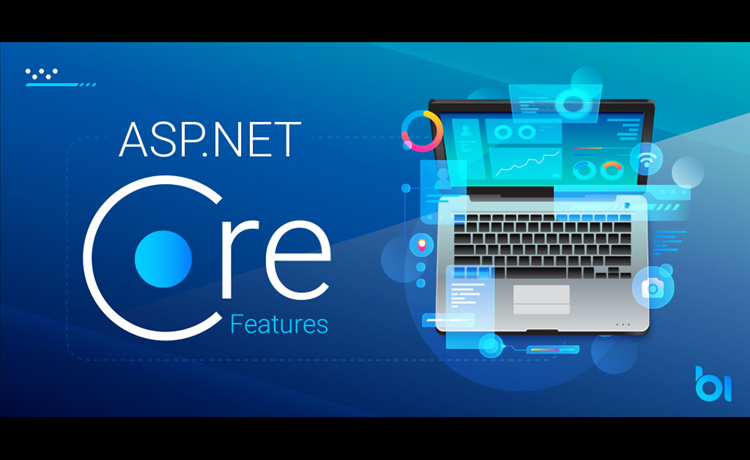
TOP 10 .NET CORE FEATURES YOU NEED TO KNOW
.Net Core is a lightweight and cross-platform version of the DotNet framework and the awesome thing is Developers required the same expertise to work with Asp.Net Core as .Net Framework.
With Every Update, new features are added that help developers deploy high-performance & highly scalable web applications using less Code.
Are you a Web Developer or want to Develop an app for Desktop or Mobile, If you are a Game Developer or want to work on Machine Learning, DotNet Core is here for you.
Yes, all these kind of applications can be developed using .Net Core.
Here’s the top .Net Core Features you need to know:
1. Cross-platform & container support
With the introduction of .NET Core, you can now create ASP.NET applications and deploy them to Windows, Linux, and macOS. Microsoft and the community have put a huge effort into making Linux a first-class citizen for running ASP.NET.
Containers are eating the clouds these days. Docker, Kuberenetes and other technologies are all the rage. ASP.NET Core allows developers to utilize all of these new technologies. Microsoft Azure even has support for deploying your application to containers and Kubernetes.
2. High performance
Some say that performance is a critical feature of your software. I tend to agree! With the introduction of ASP.NET Core and the Kestrel web server, ASP.NET is touted as one of the fastest web application frameworks available. TechEmpower has some cool benchmarks you can check out.
The technology that powered the ASP.NET integrated pipeline and IIS was roughly 15 years old. It did everything and carried a lot of baggage with it. The new Kestrel web server was redesigned from the ground up to take advantage of asynchronous programming models, be much more lightweight, and fast!
3. Asynchronous via async/await
ASP.NET has excellent support for utilizing asynchronous programming patterns. Async is now implemented in all common .NET Framework classes and most third-party libraries. Most modern applications spend most of their time and CPU cycles waiting for database queries, web service calls, and other I/O operations to complete.
One of the reasons ASP.NET Core is faster is its extensive use of asynchronous patterns within the new MVC and Kestrel frameworks.
4. Unified MVC & Web API frameworks
Before ASP.NET Core, developers were most commonly using the MVC and Web API frameworks. MVC was tailored to creating web applications that served up HTML. Web API was designed to create RESTful services using JSON or XML.
With ASP.NET Core, MVC and Web API have been merged together. There was always a lot of overlap with the two frameworks. MVC could always return JSON data instead of HTML. Combining them was a good move and simplifies development.
With ASP.NET Core we also have the new Razor Pages. They extend the MVC framework to allow encapsulating the controller and model aspects of a page together with two-way binding. They are sort of a replacement for WebForms while using the familiar Razor syntax.
5. Multiple environments and development mode
One of my favorite features is the new environment feature. It allows you to easily differentiate parts of your code for their behavior in development, staging, production, etc. There was no standard way to do this before ASP.NET Core.
For example, it is used within your Startup.cs file to help configure your application. In this case, whether or not we want to show a more detailed exception page for development only.
Environments are perfect for using different CSS or Javascript files. Use your CDN in production, but local files during development. This is a snippet out of my Razor layout view.
6. Dependency Injection
One of the great new features of ASP.NET Core is built in dependency injection. It is heavily used within ASP.NET MVC itself. It is the preferred way that things like logging contexts, database contexts, and other things are passed into your MVC controllers.
7. WebSockets & SignalR
ASP.NET has first class support for WebSockets. This can be used to persist long running connections and communicate back and forth with the browser. SignalR is a full framework that is also available that makes it easy handle common scenarios.
We use SignalR very heavily at Stackify. For example, when viewing the current monitoring data about one of your servers, every time we receive new data, we immediately push it to your browser so you can see it update in real time. These types of scenarios are perfect for WebSockets and SignalR makes it easy to do.
8. Cross-Site Request Forgery (CSRF) Protection
Security is important. It is also one of those things that can be a lot of work to prevent certain types of attacks. CSRF is in referencing to hijacking users authenticated session to perform an action that they did not initiate.
For example, let’s pretend that you log in to your bank account and then navigate to a different website. If that other website could do a POST to your bank website to transfer funds, that would be a bad thing. It could potentially do that if your online session on the banking website is valid and the bank does not properly validate requests.
ASP.NET has a good framework that is available to prevent these types of attacks. It generates anti-forgery tokens.
Learn more: XSRF/CSRF Prevention in ASP.NET MVC and Web Pages
9. “Self hosted” Web Applications
Sometimes you need to make a web application that will be deployed on to a desktop and not a server running IIS. Our free ASP.NET profiler, Prefix, is a perfect example of this. Its front end is all HTML that is loaded from an ASP.NET application running as a Windows Service.
You can create a self-hosted ASP.NET web application several different ways. In .NET 4.5 you could accomplish it by using Owin, Nancy, or WCF. For Prefix, we use ASP.NET Web API with Owin.
With ASP.NET Core, you can also use the standard Kestrel web server. One of the great advantages of .NET Core is that your web application is essentially a console application. IIS just sits in front of it as a reverse proxy. This means that you can also deploy your app only with kestrel for non-server based use cases, like Prefix.
10. Action Filters
One of the great features of ASP.NET is the support for extensible filters. This allows you to implement functionality that can be applied to an entire controller or action without modifying the action itself.
Filters are used to specify caching, error handling, authorization, or any custom logic you would like to implement.
Conclusion
ASP.NET Core has been a nice upgrade over previous versions. In this article, we highlighted some of the key features you should be aware of. Some are new, some are just key features of ASP.NET that have existed for a while.
Our products, Prefix and Retrace, both provide excellent support for ASP.NET Core. If monitoring the performance of your applications is important, you definitely want to checkout Retrace.
Thanks, for reading the blog, I hope it helps you. Please share this link on your social media accounts so that others can read our valuable content. Share your queries with our expert team and get Free Expert Advice for Your Business today.
